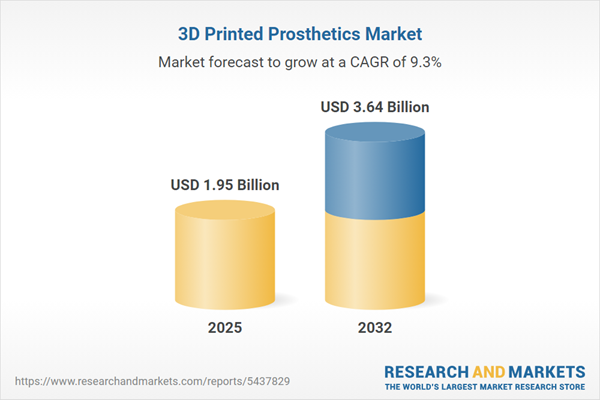Speak directly to the analyst to clarify any post sales queries you may have.
The 3D printed prosthetics market is rapidly transforming healthcare delivery, enabling senior decision-makers to meet increasing demands for personalized care and operational efficiency. Adoption of advanced manufacturing and digital workflows positions healthcare organizations for greater adaptability amid evolving regulatory and patient expectations.
Market Snapshot: 3D Printed Prosthetics Market Overview
The global 3D printed prosthetics market is exhibiting strong growth, as a result of innovative manufacturing models for medical devices tailored to complex clinical needs. In 2024, this market reached USD 1.78 billion, with projections indicating an expansion to USD 1.95 billion by 2025. A compound annual growth rate of 9.33% is anticipated through 2032, underscoring the robustness of additive manufacturing adoption. Increasing reliance on digital workflows and advanced materials is elevating the quality and customization of prosthetic solutions. Hospitals, clinics, and related organizations are integrating these technologies to diversify patient services and answer the rising call for functionally precise, aesthetically improved prosthetic devices.
Scope & Segmentation of the 3D Printed Prosthetics Market
- Technology Platforms: Key 3D printing methods—Fused Deposition Modeling, Multi Jet Fusion, Stereolithography, and Selective Laser Sintering—deliver flexibility for both prototype development and large-scale device production, addressing rapidly changing clinical scenarios.
- Material Types: Diverse materials serve unique clinical objectives—nylon provides versatility, PEEK ensures high-grade mechanical strength, photopolymer resin enables precision, and titanium alloys offer robust, biocompatible properties, all of which shape device compliance and user satisfaction.
- Applications: The market serves extensive use cases, including dental prosthetics, facial reconstruction, upper- and lower-limb solutions, and ocular devices. This enables providers to manage both routine care and sophisticated reconstruction procedures, broadening the reach of advanced prosthetic solutions.
- End Users: Core stakeholders are hospitals, ambulatory surgery centers, specialty clinics, and homecare providers; these groups integrate new prosthetic technologies to enrich care quality and align operations with patient needs.
- Prosthetic Types: Market participants offer both customized and standardized prosthetics, supporting balanced approaches to resource deployment and ensuring tailored patient care programs across various healthcare settings.
- Geographical Coverage: Coverage includes The Americas, Europe, Middle East & Africa, and Asia-Pacific, providing a comprehensive view of infrastructure variations, regulatory differences, and technology uptake, which informs regional strategic planning.
- Company Profiles Analyzed: Industry analysis encompasses major firms such as Össur hf., Ottobock SE & Co. KGaA, Stratasys Ltd., 3D Systems, Inc., Materialise NV, Next21 Co., Ltd., UNYQ, Inc., WillowWood Global, LLC, Bespoke Innovations, LLC, and Blue Sky Bio, LLC, giving stakeholders an understanding of competitive positioning.
Key Takeaways for Senior Decision-Makers
- Additive manufacturing is enabling faster delivery of custom prosthetics, translating to improved clinical workflows and better responsiveness to patient-specific treatment requirements.
- Continuous advancements in polymer and metal science have allowed prosthetic devices to be more durable and adaptable, promoting extended use and supporting expansion into new healthcare environments.
- Digital integration—utilizing computer-aided design and medical imaging—enhances prosthetic fit precision and overall patient satisfaction, facilitating the delivery of premium healthcare services.
- Emphasis on user-centric innovation drives notable improvements in both comfort and aesthetic customization, offering a pathway for organizations aiming to meet the heightened expectations for personalized care.
- Distributed manufacturing and regional production hubs improve supply dependability and reduce operational risk, strengthening organizations against uncertainty linked to global disruptions.
- Changing regulatory frameworks require proactive compliance and agile adaptation, especially as reimbursement methodologies and import regulations are updated, to ensure uninterrupted organizational engagement in the sector.
2025 Tariff Impact on the 3D Printed Prosthetics Sector
Impending tariff changes in the United States are prompting organizations to reevaluate both procurement strategies and regional manufacturing models. This shift enhances supply continuity and reduces vulnerability to regulatory variability. Small and medium-sized enterprises, in particular, must adopt adaptive sourcing and maintain precise financial oversight to address evolving market and compliance demands.
Methodology & Data Sources
This report draws on direct interviews with industry leaders, collaboration with clinical professionals, and thorough evaluation of current regulatory and scientific publications. Data analysis leverages publicly curated repositories to ensure reliable, actionable guidance for executive-level decision-making in the 3D printed prosthetics field.
Why This Report Matters
- Equips senior leaders with actionable intelligence for investment prioritization and organizational strategy related to emerging 3D printing technologies.
- Clarifies operational segments, core technology trends, and key compliance drivers to inform confident market entry and risk management initiatives.
- Supports the development of resilient supply chains and distribution models that address regulatory demands across global and regional markets.
Conclusion
This report enables senior decision-makers to strengthen resilience and drive innovation, fostering successful adoption of 3D printed prosthetics in evolving healthcare environments.
Additional Product Information:
- Purchase of this report includes 1 year online access with quarterly updates.
- This report can be updated on request. Please contact our Customer Experience team using the Ask a Question widget on our website.
Table of Contents
3. Executive Summary
4. Market Overview
7. Cumulative Impact of Artificial Intelligence 2025
Companies Mentioned
The companies profiled in this 3D Printed Prosthetics market report include:- Össur hf.
- Ottobock SE & Co. KGaA
- Stratasys Ltd.
- 3D Systems, Inc.
- Materialise NV
- Next21 Co., Ltd.
- UNYQ, Inc.
- WillowWood Global, LLC
- Bespoke Innovations, LLC
- Blue Sky Bio, LLC
Table Information
| Report Attribute | Details |
|---|---|
| No. of Pages | 195 |
| Published | October 2025 |
| Forecast Period | 2025 - 2032 |
| Estimated Market Value ( USD | $ 1.95 Billion |
| Forecasted Market Value ( USD | $ 3.64 Billion |
| Compound Annual Growth Rate | 9.3% |
| Regions Covered | Global |
| No. of Companies Mentioned | 11 |









